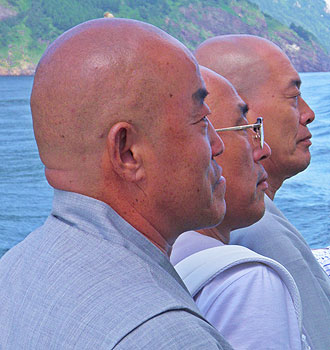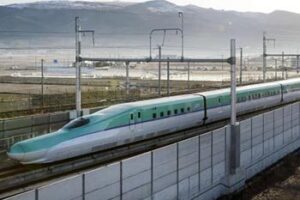
Zipping Across the country on a Korean Bullet Train
By David Rich

I began writing this as South Korean bullet train KTX #139 pulled out of Seoul Station bound diagonally across the country to Busan, guaranteeing two hours of mesmerization.
Moments before, I entered a photography contest in Vienna, Austria, courtesy of onboard Wi-Fi.
Exactly on the second of its scheduled departure, KTX #139 pulled out smoothly without the hint of a clickety-clack, ride like silk.
This was nothing like any train I’d ridden anywhere. The overhead screen listed arrival times at the three stations en route and presto, we were up to 100 miles (160 kilometers) per hour.
Welded Rail for Bullet Trains
The speed was also displayed on the inch-thin monitor when smooth as a feather we hit 177 mph (285 kph). The almost complete lack of sound was courtesy of continuous welded rail.
The KTX was a far cry from the piercing shriek of screeching jet engines aloft, yet we traveled faster, discounting the hour or two advance check-in at airports, and at half the price of a plane ticket.
In addition to perfect quiet, a fetching cabin attendant slid a steaming cappuccino onto my table as I again pulled up the Vienna photography contest, passing adjacent freeway traffic like it was standing still. Oh yeah, rush hour in Seoul, it was standing still.
As usual on Korean public transport, I was the only gringo in sight, but everyone is always so solicitous. I only have to effect a blank look, which I can do with remarkable ease, and I’m kindly asked, “May I help you?”
Thus after control paneling, my keyboard into Korean a twenty-something kid had helped me log onto the Wi-Fi, which required Korean.
An hour later I found out it wasn’t free Wi-Fi he’d logged me into but gratuitously into his personal pay-to-surf account, the well-beyond politeness typical of most Koreans I’ve encountered.

I sat back and watched the scenery slide by on fast forward:
* ubiquitous tunnels flashing like black blips
* over sprawling rivers like, whoa, was that a mighty river we crossed?
* passing buses going 100 kph (62 mph) in their special freeway lanes as we flew by at 300 kph+ (186mph+)
* past Korean cities looking like high-rise Legolands of apartments to the horizon since 80% of Koreans go home in an elevator. It was like IMAX in surround, valleys filled with greenhouses, orchards, and rice fields, church steeples embellished with vertical Korean letters (30% of Koreans are Christians) and thoroughly modern cities under a glinting autumn sun.

Many developed countries fly bullet trains for principal public transportation from Japan and France to Germany, China and Korea. California might be next.
To reach my final destination, I reluctantly disembarked the KTX, taking a Mugunghwa train, which must be Korean for slow with many stops:
* jerky-jerk starting up and slight clunkety-clack though no clickety-clack
* no table for my laptop
* across wide meandering rivers we wove and weaved about and must have gotten up to 60 mph on a couple of occasions
* noisy
* traffic on the next-door freeway drawing inexorably ahead as we snaily rolled along
* stopping every twenty or ten minutes, commuters on and off, inching ahead infinitesimally.
Would I ever reach Andong? One thing I’d learned. The Governator of California had better get on the stick and buy a few cool-cool bullets; get away from the last century’s Mugunghwas!
When you fly Korean KTX:
Conductors in Korea don’t check tickets, never bothering the passengers except those boarding without tickets, sitting in seats for which no ticket has been purchased, which are few and far between on KTX.
Korea is the size of Indiana with a population of 50 million people, more internationally sold car brands than the USA and further advanced technologically in many areas, particularly public transportation, where bus-stop electronic sign boards update bus arrivals by the minute and smart cards are used to pay for almost everything from public transportation to convenience stores.
For example, the Seoul Metropolitan Subway is one of the most heavily used subway systems in the world with more than eight million daily trips. It is also one of the biggest subway stations worldwide, running 179.4 miles in length.
Enjoy rail travel? Take dozens of travel articles to go on your Kindle with our Rail Travel Plane Reader.
Eurail Passes: What to Know about Buying a Europe Train Pass
- Mali: Djenne, Vivid Colors and Timbuktu - February 28, 2024
- Pantanal, Brazil: Dozens of Magnificent Creatures - September 17, 2019
- David Rich: The Monkey on My Back to See it All - November 12, 2018





